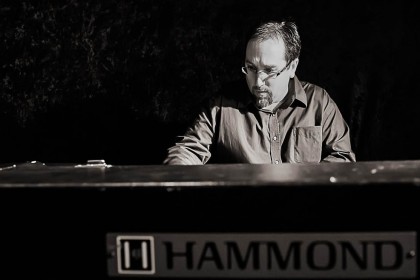
Born in Toledo on March 17, 1974, Oswanski started serious piano studies as a child with Mark Kieswetter, an Ohio jazz legend whose credits include gigs with Zoot Sims, Jack Sheldon, James Moody, and a three-year stint as musical director for Jon Hendricks. At the same time, Oswanski got intimately familiar with the accordion, often performing with his father’s polka band. He started gigging widely as a precocious high school pianist, receiving invaluable experience with numerous Cincinnati tri-state jazz veterans, including Jimmy Cook, Paul Keller, Pete Siers, Ernie Krivda and Brad Sharp, who all generously mentored him. As an electric bassist, he gigged widely with Toledo jazz piano stalwart Eddie Abrams. It was Oswanski’s love of bass lines that drew him to the mighty B-3, an instrument introduced to him by Bill Heid, a well-traveled organist who has earned a cult reputation among B-3 fans.
“I used to hear Bill playing at Rusty’s all the time,” Oswanski says, referring to a Toledo music spot. “I bought my first organ from him, and he was my main organ influence.”
After winning numerous awards from the International Association of Jazz Educators, DownBeat magazine and an array of festivals, Oswanski earned a full scholarship to the Manhattan School of Music, where he studied with noted pianists Harold Danko and Garry Dial. Within months of moving to New York City in 1992, he got a call from Maynard Ferguson at the recommendation of Tim Ries, a friend since the older saxophonist took the junior high jazzhead under his wing. He spent five years with Ferguson playing piano, keyboards and B-3, and managed to finish his undergraduate degree between international tours. Ferguson also featured Oswanski on two Concord Jazz albums, 1995’s These Cats Can Swing and 1998’s Brass Attitude, which includes two Oswanski originals (on the new album he revisits one piece, the gorgeous ballad “Milk of the Moon” that Ferguson hailed for “subtlety, colors, and beauty” hinting at “the writing of Gil Evans”).
“Working with Maynard was a fantastic experience,” Oswanski says. “He really encouraged us to write. The whole idea was to be able to explore musically, to bring in what you have. Then if it works its way into the set, there was a good chance you’d be able to record it.”
By the time he came off the road with Ferguson, Oswanski was looking to focus on the B-3. At the time there were only a handful of organ players extending the instrument’s post-Larry Young vocabulary. In demand as an accomplished accordionist endorsed by Victoria Accordion Company, he works in a wide array of musical settings. Oswanski’s busy calendar as a session player and sideman is one reason that he’s making a relatively late debut as a leader. Another is that for more than a decade he’s helped run drummer Martin Paglione’s Applied Microphone Technology, a company devoted to making mics designed for specific instruments. He got involved with AMT because he helped them design an accordion microphone system out of his quest for accurate, high quality sound. Now the jazz world is getting a chance to hear just what sound Oswanski has to offer.
